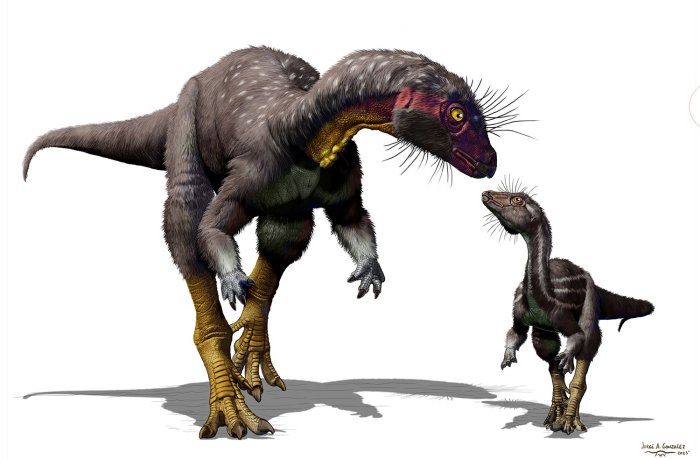Jan Bartek – AncientPages.com – During the age of dinosaurs, life thrived on the surface and beneath it. Recent paleontological findings have unveiled a new ancestor of Thescelosaurus, providing compelling evidence that these creatures partially inhabited underground burrows. This discovery significantly expands our knowledge of mid-Cretaceous ecosystems.
Fona herzogae. Credit: Jorge Gonzalez.
The newly identified species offers valuable insights into the diverse lifestyles of prehistoric animals, revealing a more complex picture of both terrestrial and subterranean habitats during this fascinating period of Earth’s history.
The recently discovered dinosaur species, Fona herzogae [/Foat’NAH/ herzogae], inhabited what is now Utah approximately 99 million years ago. During this period, the region was characterized by a vast floodplain ecosystem, situated between an extensive inland ocean to the east and active volcanic and mountainous terrain to the west. The environment was notably warm, humid, and muddy, with numerous rivers traversing the landscape.
Researchers from North Carolina State University and the North Carolina Museum of Natural Sciences began excavating fossils of Fona herzogae and other specimens of the same species in 2013. These remains were found in the Mussentuchit Member of the Cedar Mountain Formation. The exceptional preservation of these fossils, coupled with certain distinctive features, led scientists to hypothesize that these dinosaurs may have engaged in burrowing behavior.
Fona herzogae was a small herbivorous dinosaur, comparable in size to a large dog, with a relatively simple body structure. Unlike its more ornate relatives such as horned, armored, or crested dinosaurs, Fona lacked elaborate physical features. However, this absence of ornamental characteristics does not diminish the significance or interest of this species.
Fona shares several anatomical features with animals known for digging or burrowing, such as large bicep muscles, strong muscle attachment points on the hips and legs, fused bones along the pelvis—likely to help with stability while digging—and hindlimbs that are proportionally larger than the forelimbs. But that isn’t the only evidence that this animal spent time underground.
“The bias in the fossil record is toward bigger animals, primarily because in floodplain environments like the Mussentuchit, small bones on the surface will often scatter, rot away, or become scavenged before burial and fossilization,” says Haviv Avrahami, Ph.D. student at NC State and digital technician for the new Dueling Dinosaurs program at the North Carolina Museum of Natural Sciences.
“But Fona is often found complete, with many of its bones preserved in the original death pose, chest down with splayed forelimbs, and in exceptionally good condition,” Avrahami says. “If it had already been underground in a burrow before death, it would have made this type of preservation more likely.”
“Fona skeletons are way more common in this area than we would predict for a small animal with fragile bones,” Lindsay Zanno, associate research professor at NC State, head of paleontology at the North Carolina Museum of Natural Sciences and corresponding author of the work says.
“The best explanation for why we find so many of them, and recover them in small bundles of multiple individuals, is that they were living at least part of the time underground. Essentially, Fona did the hard work for us, by burying itself all over this area.”
Fona herzogae. Credit: Jorge Gonzales
The research on Fona’s subterranean habits is ongoing, with scientists yet to locate its specific burrows. However, valuable insights can be drawn from the discovery of tunnels and chambers belonging to its close relative, Oryctodromeus, in Idaho and Montana. These findings provide strong evidence supporting the hypothesis that Fona also engaged in burrowing behavior.
The genus name Fona has cultural significance, derived from the creation mythology of the Chamorro people, who are indigenous to Guam and the Pacific Mariana Islands. In their ancestral narrative, Fo’na and Pontan were sibling explorers who discovered the island. According to the legend, they subsequently transformed into the land and sky, respectively, becoming integral parts of the Chamorro cosmology.
This naming choice not only honors the local cultural heritage but also highlights the importance of integrating indigenous knowledge with scientific discoveries. It serves as an example of how paleontology can intersect with cultural anthropology, enriching our understanding of both natural history and human cultural diversity.
Fona is also a distant relative of another famous North Carolina fossil: Willo, a Thescelosaurus neglectus specimen currently housed at the museum and also thought to have adaptations for a semifossorial—or partially underground—lifestyle.
“T. neglectus was at the tail end of this lineage—Fona is its ancestor from about 35 million years prior,” Avrahami says.
The researchers believe Fona is key to expanding our understanding of Cretaceous ecosystems.
“Fona gives us insight into the third dimension an animal can occupy by moving underground,” says Avrahami. “It adds to the richness of the fossil record and expands the known diversity of small-bodied herbivores, which remain poorly understood despite being incredibly integral components of Cretaceous ecosystems.”
“People tend to have a myopic view of dinosaurs that hasn’t kept up with the science,” Zanno says. “We now know that dinosaur diversity ran the gamut from tiny arboreal gliders and nocturnal hunters, to sloth-like grazers, and yes, even subterranean shelterers.”
The study was published in The Anatomical Record
Written by Jan Bartek – AncientPages.com Staff Writer



